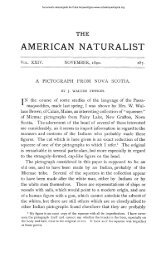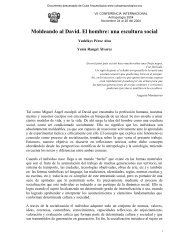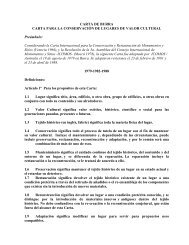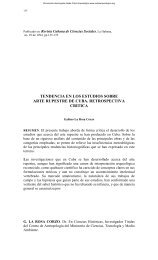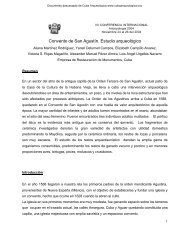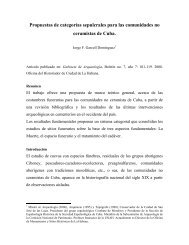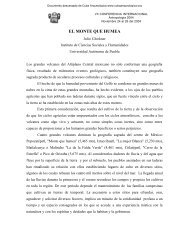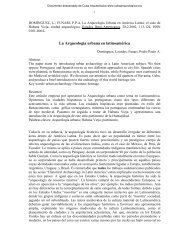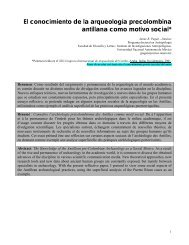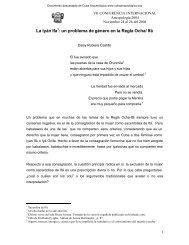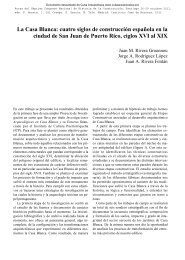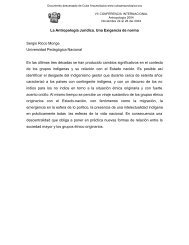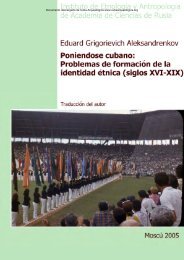Envisioning Ancient Human Plant Use at the Río Tanamá Site #2 ...
Envisioning Ancient Human Plant Use at the Río Tanamá Site #2 ...
Envisioning Ancient Human Plant Use at the Río Tanamá Site #2 ...
Create successful ePaper yourself
Turn your PDF publications into a flip-book with our unique Google optimized e-Paper software.
Starch Grains Analysis, <strong>Río</strong> <strong>Tanamá</strong> <strong>Site</strong> <strong>#2</strong> (AR-039), Arecibo, Puerto Rico<br />
<strong>Envisioning</strong> <strong>Ancient</strong> <strong>Human</strong> <strong>Plant</strong> <strong>Use</strong> <strong>at</strong> <strong>the</strong> <strong>Río</strong> <strong>Tanamá</strong> <strong>Site</strong> <strong>#2</strong> (Arecibo-<br />
039) Through Starch Analysis of Lithic and Clay Griddle Implements<br />
Dr. Jaime R. Pagán Jiménez<br />
Unedited version. Report Submitted to Sou<strong>the</strong>astern Archaeological Research, Inc. (2006). No citar este<br />
documento sin el consentimiento escrito de su autor.<br />
1. Introduction<br />
This report discusses <strong>the</strong> results derived from <strong>the</strong> analysis of seven starch residue samples<br />
obtained from five stone tools and one clay griddle (two samples from three fragments of a<br />
simple burén) recovered from <strong>Río</strong> <strong>Tanamá</strong> <strong>Site</strong> <strong>#2</strong> (AR-039), loc<strong>at</strong>ed in <strong>the</strong> Arecibo municipality<br />
of northwestern Puerto Rico. This study provides new d<strong>at</strong>a th<strong>at</strong> contributes to a better<br />
understanding of <strong>the</strong> n<strong>at</strong>ure of plant use and consumption during one of <strong>the</strong> most intriguing<br />
periods of socio-economical and cultural change in <strong>the</strong> ancient history of Puerto Rico.<br />
The time frame pertinent to this study can be bracketed between ca. AD 640 and AD 770,<br />
covering Periods II-b (l<strong>at</strong>e Cuevas) and III-a (Ostiones) of <strong>the</strong> regional chronology devised by<br />
Rouse (1992). Period II-b (ca. AD 400-800) is a time when <strong>the</strong> Saladoid people, interacting with<br />
o<strong>the</strong>r peoples in a multi-cultural island scenario, probably began to emphasize <strong>the</strong>ir social and<br />
economical activities to a new regional political context based on settlement hierarchies.<br />
According to various regional analyses produced for <strong>the</strong> eastern part of Puerto Rico (Curet 1987<br />
and 1992; Pagán Jiménez 2007; Rodríguez López 1990 and 1992), during this phase of changes,<br />
<strong>the</strong> Saladoid-Cuevas people –different to <strong>the</strong> settlement p<strong>at</strong>tern developed by <strong>the</strong> early Hacienda<br />
Grande ones– began to occupy some inland portions of Puerto Rico. At <strong>the</strong> same time, <strong>the</strong>ir<br />
settlement configur<strong>at</strong>ions on a regional basis began to show some kind of clusters made up of<br />
individual villages, probably rel<strong>at</strong>ed with broader geo-political and/or demographic changes th<strong>at</strong><br />
emerged during this phase. Period III-a (ca. Rouse’s AD 900-1200/1300) is a time when marked<br />
inequality and social complexity seem to have emerged in tandem with ‘monumental’<br />
architecture in <strong>the</strong> form of sites with multiple plazas and ball court precincts (Curet and Oliver<br />
1998; Curet 2005: 22-26, 90-91; Siegel 1999). However, questions about <strong>the</strong> emergence of elites<br />
(caciques) and <strong>the</strong> n<strong>at</strong>ure of <strong>the</strong>ir botanical and economical cultures are difficult to address given<br />
th<strong>at</strong> <strong>the</strong> remains of crops from pre-Columbian archaeological contexts are few and far between<br />
1
Starch Grains Analysis, <strong>Río</strong> <strong>Tanamá</strong> <strong>Site</strong> <strong>#2</strong> (AR-039), Arecibo, Puerto Rico<br />
despite all <strong>the</strong> recent advances in tropical archaeobotany (Newsom and Wing 2004; and de<br />
France and Newsom 2005).<br />
The significance of most of <strong>the</strong> identified plants (and animal) species are still largely discussed <strong>at</strong><br />
a coarse level of resolution (subseries and series) with <strong>the</strong> consequence th<strong>at</strong> understanding wh<strong>at</strong><br />
is going on <strong>at</strong> <strong>the</strong> levels of <strong>the</strong> household, <strong>the</strong> community, and discrete social groups remains<br />
vague. It is in this context th<strong>at</strong> this starch residue analysis will serve as an initial effort toward<br />
gaining new insights on <strong>the</strong> ancient agrarian economies of <strong>the</strong> Caribbean, especially for <strong>the</strong> l<strong>at</strong>e<br />
Cuevas (Saladoid) and early Ostiones (Ostionoid) times.<br />
The d<strong>at</strong>a g<strong>at</strong>hered from this study, in spite of being limited, suggests th<strong>at</strong> during <strong>the</strong> l<strong>at</strong>e Cuevas<br />
and early Ostiones times <strong>the</strong>re were interesting social and ethnobotanical dynamics never<br />
described before in a clear way for this peoples. The complexity of such dynamics is difficult to<br />
stress here in detail due to <strong>the</strong> scarcity of <strong>the</strong> archaeobotanical samples studied. However, with<br />
this d<strong>at</strong>a we have a more realistic picture of <strong>the</strong> Cuevas-Ostiones botanical cultures for <strong>the</strong><br />
Arecibo-39 community, which might serve to develop comprehensive st<strong>at</strong>ements about <strong>the</strong> so<br />
called transition between <strong>the</strong> Saladoid and Ostionoid peoples and cultures.<br />
2. <strong>Site</strong> and Tool Contexts<br />
2a. Arecibo-39 (<strong>Site</strong> <strong>#2</strong>)<br />
The Phase III Archaeological Mitig<strong>at</strong>ion <strong>at</strong> <strong>Río</strong> <strong>Tanamá</strong> <strong>Site</strong> <strong>#2</strong> (or Arecibo-39) produced a<br />
rel<strong>at</strong>ively high quantity of artifacts associ<strong>at</strong>ed, in one way or ano<strong>the</strong>r, to plant food processing<br />
and/or cooking. The entire site has been defined as a L<strong>at</strong>e Cuevas/Early Ostiones activity area<br />
because both ceramic styles are mixed toge<strong>the</strong>r. In terms of traditional lithic and pottery<br />
morphological classific<strong>at</strong>ions, many of those implements can be linked to various village<br />
activities where people were interacting internally and externally <strong>at</strong> different social and cultural<br />
levels. It should be noted th<strong>at</strong> it is during such intra and inter-communal activities, like those<br />
rel<strong>at</strong>ed to food plant production and <strong>the</strong> processing-cooking of <strong>the</strong> resulting meals, when special<br />
human interactions (e.g., negoti<strong>at</strong>ions-contest<strong>at</strong>ions) between community members takes place<br />
(Pagán Jiménez 2007).<br />
2
Starch Grains Analysis, <strong>Río</strong> <strong>Tanamá</strong> <strong>Site</strong> <strong>#2</strong> (AR-039), Arecibo, Puerto Rico<br />
Table 1. Summary of Artifacts Selected for Analysis by Provenience, Type, and Loc<strong>at</strong>ion/number<br />
of Point Samples; <strong>Río</strong> <strong>Tanamá</strong> Archaeological Project (Phase III), Arecibo, Puerto Rico.<br />
Artifact<br />
Number<br />
(C<strong>at</strong>. #)<br />
Artifact 1<br />
(FS-274)<br />
Artifact 2<br />
(FS-255)<br />
Artifact 3<br />
(FS-242)<br />
Artifact 4<br />
(FS-244)<br />
Artifact 5<br />
(FS-289)<br />
Artifact 6<br />
(FS-278)<br />
Provenience Artifact type and raw<br />
m<strong>at</strong>erial<br />
E.U. 15<br />
Fe<strong>at</strong>ure 3; Single Str<strong>at</strong>um,<br />
Level 2 (21 cmbd)<br />
E.U. 12<br />
Fe<strong>at</strong>ure 3; Single Str<strong>at</strong>um,<br />
Level 3 (27-30 cmbd)<br />
E.U. 12<br />
Fe<strong>at</strong>ure 3; Single Str<strong>at</strong>um,<br />
Level 3 (29 cmbd)<br />
E.U. 12<br />
Fe<strong>at</strong>ure 3; Single Str<strong>at</strong>um,<br />
Level 4 (30-33 cmbd)<br />
E.U. 16<br />
Fe<strong>at</strong>ure 3; Single Str<strong>at</strong>um,<br />
Level 4 (27-37 cmbd)<br />
E.U. 16<br />
Fe<strong>at</strong>ure 3; Single Str<strong>at</strong>um,<br />
Level 2 (17-27 cmbd)<br />
3 griddle fragments:<br />
clay<br />
Conical pestle:<br />
limestone<br />
Edge b<strong>at</strong>tered cobble:<br />
basalt<br />
Edge ground-cobble:<br />
basalt<br />
“Nutting” stone:<br />
diorite<br />
Edge b<strong>at</strong>tered cobble:<br />
Diorite<br />
<strong>Use</strong> wear sections and<br />
number of samples points<br />
in paren<strong>the</strong>sis<br />
<strong>Use</strong>d section (1), and opposite side<br />
(1): two samples<br />
Lab. Number<br />
and sample<br />
weight in<br />
and many clay griddle fragments. On <strong>the</strong> o<strong>the</strong>r hand, <strong>the</strong> sou<strong>the</strong>rn depression (<strong>the</strong> l<strong>at</strong>er section of<br />
3<br />
grams<br />
06-04 and 06-<br />
05 (0.079 and<br />
0.127)<br />
B<strong>at</strong>tered or pecked surfaces (1) 06-03 (0.155)<br />
Faceted and pecked sections (1) 06-01 (0.080)<br />
Faceted and pecked sections (1) 06-02 (0.037)<br />
Two concavities and pecked surfaces<br />
(1)<br />
06-06 (0.044)<br />
B<strong>at</strong>tered or pecked section (1) 06-21 (0.099)<br />
Three of <strong>the</strong> six implements analyzed for starch content came from Excav<strong>at</strong>ion Unit (EU) 12, and<br />
<strong>the</strong> o<strong>the</strong>r three came from EU 15 and 16 (Table 1; personal communic<strong>at</strong>ion, Betsy Carlson<br />
[2006] and End of Field Work Report 2005). All of <strong>the</strong>se artifacts were obtained from Fe<strong>at</strong>ure 3,<br />
which is a large deposition area (between 11-14 meters) made up of several depressions or pits<br />
filled with midden m<strong>at</strong>erials (e.g., faunal, ceramic, and lithic remains). This cultural deposit was<br />
all one single str<strong>at</strong>um subdivided in arbitrary excav<strong>at</strong>ion levels. There is one d<strong>at</strong>e so far from EU<br />
17 (adjacent to EU 16), specifically from level 3 (29-39 cmbd) with a 2 sigma d<strong>at</strong>e of Cal. AD<br />
640-770. In order to understand <strong>the</strong> socio-cultural n<strong>at</strong>ure of Fe<strong>at</strong>ure 3, one of <strong>the</strong> aims of <strong>the</strong><br />
mitig<strong>at</strong>ion project is to compare its different areas based on <strong>the</strong> distribution and associ<strong>at</strong>ions of<br />
<strong>the</strong>ir respective m<strong>at</strong>erial culture, which includes <strong>the</strong> utilitarian artifacts (for plant processing) and<br />
<strong>the</strong>ir “embedded” vegetal sign<strong>at</strong>ures. Preliminary interpret<strong>at</strong>ions suggest <strong>the</strong> possibility th<strong>at</strong> <strong>the</strong><br />
sou<strong>the</strong>rn area (EU 12) of Fe<strong>at</strong>ure 3 can be slightly l<strong>at</strong>er in time th<strong>at</strong> <strong>the</strong> nor<strong>the</strong>rn area (EU 16).<br />
One of <strong>the</strong> evidences used in such an interpret<strong>at</strong>ion is <strong>the</strong> lower percentage of Cuevas sherds with<br />
respect to <strong>the</strong> Ostiones ones in <strong>the</strong> sou<strong>the</strong>rn area.<br />
O<strong>the</strong>r differences between <strong>the</strong> areas are not th<strong>at</strong> clear and simple, but <strong>the</strong> fact is th<strong>at</strong> <strong>the</strong>y are not<br />
identical assemblages. In <strong>the</strong> one hand, <strong>the</strong> nor<strong>the</strong>rn depression (presumably <strong>the</strong> earlier section<br />
of Fe<strong>at</strong>ure 3) has cooking bone remains like fish, bird, and hutia as well as fire-cracked rocks,
Starch Grains Analysis, <strong>Río</strong> <strong>Tanamá</strong> <strong>Site</strong> <strong>#2</strong> (AR-039), Arecibo, Puerto Rico<br />
Fe<strong>at</strong>ure 3) has more lithics/cobbles, very little bone (only hutia), and human remains. As a point<br />
of interest for this archaeo-microbotanical analysis, a gre<strong>at</strong> part of <strong>the</strong> microlithics studied in this<br />
volume (see Rodríguez Ramos’s Chapter in this volume) came from <strong>the</strong> nor<strong>the</strong>rn area of Fe<strong>at</strong>ure<br />
3 in spite <strong>the</strong> sou<strong>the</strong>rn area were sampled with 1/16" producing no microlithics. As many of us<br />
know, some bipolary flaked microlithics with a particular type of use wear in <strong>the</strong>ir edges, have<br />
been associ<strong>at</strong>ed with <strong>the</strong> so called cassava gr<strong>at</strong>ers. Based on <strong>the</strong> synopsis presented above, some<br />
basic questions about plant-people interactions in Arecibo-39 emerges: Can <strong>the</strong> implements<br />
selected for this study be truly rel<strong>at</strong>ed to plant processing?; wh<strong>at</strong> kind of plants-vegetal organs<br />
(exogenous or endogenous) were processed <strong>at</strong> Arecibo-39?; and finally, can we see changes in<br />
plant use and/or processing through time in spite of <strong>the</strong> limited samples and contexts analyzed?<br />
3. M<strong>at</strong>erials and Methodology of Starch Residue Analysis<br />
Table 1 describes <strong>the</strong> possible functional <strong>at</strong>tributes of <strong>the</strong> five lithic implements and <strong>the</strong> clay<br />
griddle fragments selected for analysis. All <strong>the</strong> selected implements were bagged in <strong>the</strong> field,<br />
subsequently were transported to <strong>the</strong> project’s labor<strong>at</strong>ory in Florida and finally returned to Reniel<br />
Rodríguez Ramos Lithic Labor<strong>at</strong>ory in Puerto Rico. Artifacts 1, 2 and 3 were not washed <strong>at</strong> any<br />
point in time. However, artifacts 4, 5 and 6 were washed during lab procedures. At a l<strong>at</strong>er d<strong>at</strong>e,<br />
<strong>the</strong> sediment samples were extracted from various pin-point loc<strong>at</strong>ions for each tool by Pagán<br />
Jiménez in Puerto Rico (Table 1). The reason for multiple point sampling was to insure th<strong>at</strong><br />
microbotanical sign<strong>at</strong>ures were recovered from different facets or aspects of <strong>the</strong> same tool th<strong>at</strong><br />
had evident use-wear p<strong>at</strong>terns apparently rel<strong>at</strong>ed to plant-processing functions. All <strong>the</strong> seven<br />
samples analyzed (≥0.006g each see Table 1) were processed for <strong>the</strong> separ<strong>at</strong>ion of starch grains<br />
with cesium chloride (CsCl), as discussed in <strong>the</strong> section below.<br />
The work surface of <strong>the</strong> implement was thoroughly cleaned with a new, moist rag. A sterile<br />
paper was placed on <strong>the</strong> working surface and, over <strong>the</strong> paper, <strong>the</strong> portion of <strong>the</strong> artifact to be<br />
sampled. Next, sediment residues (dry method) were extracted using a sterilized dental pick (see<br />
also Pearsall et al. 2004; Perry 2004). Finally, <strong>the</strong> extracted sediment was placed on sterile<br />
micro-centrifuge tube of 1.5 ml, which was <strong>the</strong>n placed inside sterile plastic zip-lock bag with <strong>the</strong><br />
appropri<strong>at</strong>e label.<br />
4
Starch Grains Analysis, <strong>Río</strong> <strong>Tanamá</strong> <strong>Site</strong> <strong>#2</strong> (AR-039), Arecibo, Puerto Rico<br />
For all <strong>the</strong> samples, <strong>the</strong> following protocol was applied, modified from Atchison and Fullagar<br />
(1998), Barton et al. (1998) and Pearsall et al. (2004). As it was noted earlier, each sample was<br />
placed in a sterile plastic centrifuge tube of 1.5 ml, and <strong>the</strong>n a solution of CsCl with a specific<br />
gravity of 1.79g/cm –3 was added. The objective was to separ<strong>at</strong>e <strong>the</strong> starch grains through<br />
flot<strong>at</strong>ion and to isol<strong>at</strong>e <strong>the</strong>m from o<strong>the</strong>r particles, as <strong>the</strong> starches are known to have an average<br />
specific gravity of 1.5g/cm –3 (Banks and Greenwood 1975). The separ<strong>at</strong>ion was conducted by a<br />
centrifuge running <strong>at</strong> 2500 rpm and lasting for 12 minutes during <strong>the</strong> first phase. The<br />
supern<strong>at</strong>ant, where <strong>the</strong> starch grains would be contained, was <strong>the</strong>n decanted and poured into a<br />
new sterile centrifuge plastic tube. The next step was to add distilled w<strong>at</strong>er to <strong>the</strong> sample and<br />
agit<strong>at</strong>e <strong>the</strong> mix for ten seconds. This process reduced <strong>the</strong> specific gravity of <strong>the</strong> mixture through<br />
<strong>the</strong> dilution of salt crystals with <strong>the</strong> objective of elimin<strong>at</strong>ing, with repe<strong>at</strong>ed washes, <strong>the</strong>ir<br />
presence. This last step was repe<strong>at</strong>ed two more times, but adding less w<strong>at</strong>er in each successive<br />
step, and running each sample through <strong>the</strong> centrifuge <strong>at</strong> 3200 rpm for 15 minutes. A droplet<br />
taken from remaining residue was <strong>the</strong>n placed on a sterile slide. Half a drop of liquid glycerol<br />
was added and stirred with a stick or needle in order to increase <strong>the</strong> viscosity of <strong>the</strong> medium and<br />
enhance <strong>the</strong> birefringence of <strong>the</strong> starch grains.<br />
4. The Taxonomic Ascription of <strong>the</strong> Recovered Starch Grains<br />
The study of starch grains in archaeology provides a useful means to address questions about<br />
plant utiliz<strong>at</strong>ion. It is not meant to be a substitute for o<strong>the</strong>r macro- and micro-botanical<br />
(phytolith, pollen) analytical techniques, but r<strong>at</strong>her to complement <strong>the</strong>m. As o<strong>the</strong>r studies have<br />
shown, starch residues can preserve for a long time in <strong>the</strong> imperfect, irregular (i.e., pores,<br />
fissures, cracks) surfaces of lithic and ceramic tools rel<strong>at</strong>ed to <strong>the</strong> processing of plant organs (e.g.,<br />
Haslam 2004; Loy et al. 1992; Pagán Jiménez 2002, 2005, 2007; Pearsall et al. 2004; Piperno<br />
and Holst 1998; Rodríguez Suárez and Pagán Jiménez 2007). If starch grains can be extracted<br />
from a tool and correl<strong>at</strong>ed to <strong>the</strong> starch of a known plant <strong>the</strong>n a direct link can be established<br />
between <strong>the</strong> implement and <strong>the</strong> starch-rich plant or plants th<strong>at</strong> it processed.<br />
At present Pagán Jiménez (2007) have assembled a compar<strong>at</strong>ive reference collection of starch<br />
grains obtained from modern economic plants (see also Table 2). It includes 40 specimens th<strong>at</strong><br />
have been formally described, along with 20 o<strong>the</strong>rs informally described, toge<strong>the</strong>r representing<br />
30 genera and 51 species th<strong>at</strong> encompass wild, domestic<strong>at</strong>ed, and cultiv<strong>at</strong>ed species from <strong>the</strong><br />
5
Starch Grains Analysis, <strong>Río</strong> <strong>Tanamá</strong> <strong>Site</strong> <strong>#2</strong> (AR-039), Arecibo, Puerto Rico<br />
Antilles, continental tropical America, and parts of <strong>the</strong> Old World (Pagán Jiménez 2004; 2007<br />
[Appendix B]). The detailed bi-dimensional description of <strong>the</strong> morphological traits of <strong>the</strong><br />
modern starch, through comparison, allows to identify <strong>the</strong> taxa of <strong>the</strong> archaeological starch –as<br />
long as <strong>the</strong>se grains exhibit sufficient diagnostic traits. The l<strong>at</strong>ter are previously established from<br />
<strong>the</strong> descriptive analysis of <strong>the</strong> modern samples in <strong>the</strong> reference collection. If <strong>the</strong>se conditions are<br />
not met by <strong>the</strong> archaeological starch gains, <strong>the</strong>n <strong>the</strong> taxonomic identific<strong>at</strong>ion is deemed less<br />
secure. In such cases we use <strong>the</strong> c<strong>at</strong>egories “cf.” (in reference to <strong>the</strong> closest tent<strong>at</strong>ive<br />
classific<strong>at</strong>ion) and “unidentified”. A reliable or secure identific<strong>at</strong>ion will not be established if<br />
archaeological starch grains exhibit traits th<strong>at</strong> are not documented in our reference collection or<br />
in <strong>the</strong> published liter<strong>at</strong>ure (Pearsall et al. 2004; Piperno and Holst 1998; Piperno et al. 2000;<br />
Perry 2002a, 2002b, 2004; Ugent et al. 1986).<br />
The identific<strong>at</strong>ion of archaeological starch grains was conducted with an Olympus BH-2 (with<br />
polarizing capacity) employing a 10X eyepiece with reticule and a 40X objective. The principal<br />
diagnostic element used to discern starch gains from o<strong>the</strong>r residues is <strong>the</strong> presence of <strong>the</strong><br />
extinction or Maltese cross observable under polarized light. The slides with <strong>the</strong> archaeological<br />
samples were comprehensively examined and <strong>the</strong>ir X/Y coordin<strong>at</strong>es were annot<strong>at</strong>ed to facilit<strong>at</strong>e<br />
<strong>the</strong>ir loc<strong>at</strong>ion in l<strong>at</strong>er inspections. After <strong>the</strong> analysis, <strong>the</strong> slides were stored in standard horizontal<br />
cardboard slide-holders.<br />
Table 2. Dimensions of <strong>the</strong> starch grains from some plants of <strong>the</strong> reference collection<br />
Taxa Measuring range in μm<br />
(minimum and maximum<br />
dimensions from groups of<br />
Domestic<strong>at</strong>es<br />
Maíz (Zea mays)<br />
Pollo<br />
Caribe temprano<br />
Frijol (bean)<br />
Phaseolus<br />
vulgaris L.<br />
Cultivars<br />
B<strong>at</strong><strong>at</strong>a (Sweet pot<strong>at</strong>o)<br />
Ipomoea b<strong>at</strong><strong>at</strong>as<br />
Wild<br />
Haba (Jack bean)<br />
Canavalia rosea<br />
(Sw.) D.C.<br />
Palmita de jardín<br />
Zamia<br />
portoricensis Urb.<br />
Marunguey<br />
Zamia<br />
amblyphyllidia<br />
D.W. Stev.<br />
Guáyiga<br />
Zamia pumila L.<br />
starch grains)<br />
2-28<br />
3-20<br />
10-40<br />
5-40<br />
10-53<br />
5-50<br />
1-83<br />
6-95<br />
6<br />
[Mean] and media in μm.<br />
(Standard devi<strong>at</strong>ion of <strong>the</strong><br />
media in paren<strong>the</strong>sis)<br />
[13.7414] and 13 (±3.9)<br />
[12.86] and 13 (±3.6)<br />
[21.59] and 20 (±6.1)<br />
[20.32] and 20 (±7.4)<br />
[28.24] and 28 (±8)<br />
[22.56] and 20 (±9.9)<br />
[21.75] and 18 (±13.5)<br />
[32.55] and 30 (±16)<br />
Number of measurements<br />
considered<br />
116<br />
101<br />
111<br />
100<br />
109<br />
108<br />
103<br />
110
5. Results and discussion<br />
Starch Grains Analysis, <strong>Río</strong> <strong>Tanamá</strong> <strong>Site</strong> <strong>#2</strong> (AR-039), Arecibo, Puerto Rico<br />
The analysis of <strong>the</strong> seven soil samples obtained from <strong>the</strong> six selected implements reveals <strong>the</strong><br />
presence of starches from different plants, many of <strong>the</strong>m known as food items. Artifact 1 (<strong>the</strong><br />
clay griddle or burén fragments), from which two soil samples were extracted from <strong>the</strong> used<br />
surface and from <strong>the</strong> opposite side, shows <strong>the</strong> highest species richness of food plant items (see<br />
Table 3, Figure 1). As has been discussed elsewhere (e.g., see <strong>the</strong> case of Eastern Cuba in<br />
Rodríguez Suárez and Pagán Jiménez 2007) this kind of cooking implement has shown <strong>the</strong><br />
presence, not only of plant remains, but also of faunal deriv<strong>at</strong>es (f<strong>at</strong>ty acids) th<strong>at</strong> do not<br />
corresponds with <strong>the</strong> typical uses commonly <strong>at</strong>tributed to <strong>the</strong>m (i.e., <strong>the</strong> cooking of cassava<br />
bread). The burén fragments studied here reflects basically <strong>the</strong> same general use p<strong>at</strong>tern observed<br />
in <strong>the</strong> Cuban burenes, <strong>the</strong> presence of plants such as Zamia amblyphyllidia (marunguey), possibly<br />
Zea mays (maíz), Fabaceae (probably a wild bean or frijol), Ipomoea b<strong>at</strong><strong>at</strong>as (b<strong>at</strong><strong>at</strong>a) and two<br />
starches th<strong>at</strong> m<strong>at</strong>ch nicely with those produced by wild grasses (Pl<strong>at</strong>e 1). The total absence of<br />
Manihot esculenta Cranz (manioc, cassava or yuca) is intriguing as well. The occurrence of<br />
starches from those important plant organs (tuberous stems, seeds and tuberous roots<br />
respectively) suggests a clear picture of previous and intentional grinding or pounding of <strong>the</strong>ir<br />
main vegetal organs to produce flour or for making <strong>the</strong>m (e.g., <strong>the</strong> poisonous marunguey)<br />
suitable for food consumption. Looking <strong>at</strong> <strong>the</strong> different plant starches found it can be inferred <strong>the</strong><br />
confection of different types of dough or combined ones. Thus, previous interpret<strong>at</strong>ions of <strong>the</strong><br />
presence of different sources of starch grains in burén implements is confirmed here, opening an<br />
interesting inter-island scenario (between Cuba and Puerto Rico) th<strong>at</strong> breaks down <strong>the</strong> current<br />
prevalent notion of some Caribbean scholars regarding <strong>the</strong> simple use of <strong>the</strong> burén as a cassava<br />
bread implement.<br />
7
Taxa<br />
Starch Grains Analysis, <strong>Río</strong> <strong>Tanamá</strong> <strong>Site</strong> <strong>#2</strong> (AR-039), Arecibo, Puerto Rico<br />
Table 3. Total distribution of <strong>the</strong> identified taxa from lithic and clay griddle implements <strong>at</strong> <strong>Tanamá</strong><br />
<strong>Site</strong><strong>#2</strong> (Arecibo-039).<br />
Artifact #<br />
Artifact 1<br />
<strong>Use</strong>d<br />
surface<br />
Artifact 1<br />
Non-used<br />
surface<br />
Artifact 2 Artifact 3 Artifact 4 Artifact 5 Artifact 6 Total<br />
grains<br />
1<br />
The ubiquity in Table 3 refers to <strong>the</strong> occurrence of a reliably identified taxa between <strong>the</strong> analyzed samples (<strong>the</strong>re may more than<br />
one simple per analyzed tool); tent<strong>at</strong>ive identific<strong>at</strong>ions are excluded from consider<strong>at</strong>ion.<br />
2<br />
To determine species richness per sample only <strong>the</strong> secure identific<strong>at</strong>ions are considered; tent<strong>at</strong>ive or insecure samples are<br />
excluded.<br />
Artifact 2 (or <strong>the</strong> conical pestle) showed particularly <strong>at</strong>ypical results (Table 3). Although this<br />
kind of artifact is usually rel<strong>at</strong>ed with <strong>the</strong> pounding of seeds, we only found two starches of <strong>the</strong><br />
tuberous stem of marunguey (Figure 2, Pl<strong>at</strong>e 2). Ano<strong>the</strong>r starch grain found could not be<br />
identified. It should be noted th<strong>at</strong> <strong>the</strong> general dimension of this implement is sufficiently small to<br />
infer th<strong>at</strong> it was not used to produce gre<strong>at</strong> quantities of flour for food for <strong>the</strong> entire community.<br />
This characteristic of dimension plus <strong>the</strong> intentional confection of <strong>the</strong> morphology of <strong>the</strong> artifact<br />
can be better rel<strong>at</strong>ed with <strong>the</strong> prepar<strong>at</strong>ion of religious-magical or medicinal dust. One point of<br />
interest is <strong>the</strong> presence of a consolid<strong>at</strong>ed reddish crust (maybe ochre) <strong>at</strong>tached to one of <strong>the</strong> used<br />
sides of <strong>the</strong> pestle. As we must know, <strong>the</strong> use of colorants derived from minerals is typically<br />
rel<strong>at</strong>ed to ritual or special activities (initi<strong>at</strong>ion, funerary rituals, and feasting). In this context <strong>the</strong><br />
finding of marunguey starches within an artifact more rel<strong>at</strong>ed with ritual activities can be an<br />
interesting associ<strong>at</strong>ion between Caribbean plants and island culture peoples th<strong>at</strong> probably were<br />
developing or consolid<strong>at</strong>ing mythological histories of self belonging to <strong>the</strong> territory. The<br />
marunguey starches found in o<strong>the</strong>r Caribbean archaeological sites have been linked to various<br />
social and economical activities, from <strong>the</strong> Archaic to <strong>the</strong> l<strong>at</strong>e ceramic age previous to <strong>the</strong> contact<br />
period (see also Sturtevant 1969; Veloz 1992). This plant and its deriv<strong>at</strong>e products (foods, ritual<br />
dusts), have suggested earlier <strong>the</strong> possibility of its different meanings in rel<strong>at</strong>ion to <strong>the</strong><br />
dissimilarities of <strong>the</strong> artifact histories in which <strong>the</strong>y have been found (see Pagán Jiménez et al.<br />
2005; Pagán Jiménez and Oliver 2007; Pagán Jiménez 2005 and 2007; Rodríguez Suárez and<br />
Pagán Jiménez 2007). It is plausible to think th<strong>at</strong> <strong>the</strong> marunguey, as an endogenous plant with <strong>the</strong><br />
8<br />
Ubiquity 1<br />
(%)<br />
Zamia<br />
amblyphyllidia<br />
1 2 3 28.57<br />
Phaseolus<br />
vulgaris<br />
1 2 3 28.57<br />
Zea mays 3 3 14.29<br />
cf. Zea mays 3 3 14.29<br />
Poaceae (wild) 2 2 14.29<br />
Fabaceae 1 1 14.29<br />
Ipomoea b<strong>at</strong><strong>at</strong>as 1 1 14.29<br />
Not identified 1 1 ----------<br />
Total grains 6 2 3 1 0 0 5 17 ----------<br />
Species richness 2 3 1 1 1 0 0 2 _____
Starch Grains Analysis, <strong>Río</strong> <strong>Tanamá</strong> <strong>Site</strong> <strong>#2</strong> (AR-039), Arecibo, Puerto Rico<br />
most ancient history of economical and social significance in <strong>the</strong> Caribbean paleoethnobotany,<br />
have been integr<strong>at</strong>ed in <strong>the</strong> cosmology of <strong>the</strong> different indigenous peoples of <strong>the</strong> islands as an<br />
important or vital entity. This implies th<strong>at</strong> we need to see <strong>the</strong> plants and <strong>the</strong>ir different meanings<br />
in a broader context of human interactions, where its deriv<strong>at</strong>es (dough, flour, etc.) could be<br />
understood not only as food items, but also as constituents of histories, myths, and deities rel<strong>at</strong>ed<br />
to <strong>the</strong> superstructural-cosmological level (as medicinal, magical or food for feasting).<br />
Artifact 3 (or one of <strong>the</strong> edge b<strong>at</strong>tered cobbles studied here; Figure 3) revealed only one starch<br />
grain. This residue fits well with <strong>the</strong> domestic<strong>at</strong>ed Phaseolus vulgaris or frijol th<strong>at</strong> have been<br />
found also in many o<strong>the</strong>r types of lithic artifacts (stone milling bases and pestles) and burenes<br />
from o<strong>the</strong>r Caribbean sites (Pagán Jiménez 2007; Pagán Jiménez et al. 2005; Rodríguez Suárez<br />
and Pagán Jiménez 2007). The isol<strong>at</strong>ed presence of this starch grain (associ<strong>at</strong>ed with a minimal<br />
use of this artifact in processing plants) highly suggest <strong>the</strong> use of this edge b<strong>at</strong>tered cobble in<br />
o<strong>the</strong>r pounding or flaking activities th<strong>at</strong> probably produced <strong>the</strong> pecked or b<strong>at</strong>tered surfaces<br />
observed.<br />
Interestingly, artifacts 4 and 5 (<strong>the</strong> edge ground-cobble and <strong>the</strong> “nutting” stone respectively;<br />
Figures 4 and 5) produced no starch grains probably due to <strong>the</strong> previous washing of its surfaces<br />
during previous lab procedures. The selection of those artifacts was made on <strong>the</strong> basis th<strong>at</strong>: a)<br />
<strong>the</strong>y had sufficient soil <strong>at</strong>tached to <strong>the</strong> cracks and pores of <strong>the</strong> used facets and b) o<strong>the</strong>r similar and<br />
washed lithic artifacts from o<strong>the</strong>r Puerto Rican sites, <strong>at</strong> least in <strong>the</strong> case of <strong>the</strong> edge groundcobbles,<br />
demonstr<strong>at</strong>es <strong>the</strong> occurrence of starches <strong>at</strong>tached to <strong>the</strong>ir cracks, fissures and pores.<br />
O<strong>the</strong>r edge-ground cobbles studied before (washed or unwashed, see Pagán Jiménez 2007) were<br />
generally made from basalt and produced small quantities of starches, thus indic<strong>at</strong>ing th<strong>at</strong> <strong>the</strong><br />
faceted and heavily polished surfaces produced in those kinds of artifacts are not so deep or<br />
irregular to facilit<strong>at</strong>e <strong>the</strong> incrust<strong>at</strong>ion of starches. The “nutting” stone analyzed here has not been<br />
studied before in any Puerto Rican archaeological site. However <strong>the</strong>re are some marks near <strong>the</strong><br />
concavities sampled th<strong>at</strong> suggest ano<strong>the</strong>r types of use more rel<strong>at</strong>ed to <strong>the</strong> bipolar reduction of<br />
stones (Rodríguez Ramos 2007, personal communic<strong>at</strong>ion) than to <strong>the</strong> processing of hard co<strong>at</strong><br />
seeds like <strong>the</strong> corozo palm fruits (Acrocomia media). There are more possible explan<strong>at</strong>ions to<br />
make a plausible account for <strong>the</strong> total absence of starch grains in those artifacts (e.g.,<br />
pedological/taphonomical processes), but unfortun<strong>at</strong>ely we do not have more direct d<strong>at</strong>a<br />
9
Starch Grains Analysis, <strong>Río</strong> <strong>Tanamá</strong> <strong>Site</strong> <strong>#2</strong> (AR-039), Arecibo, Puerto Rico<br />
(chemical-physical soil processes) to elucid<strong>at</strong>e this preserv<strong>at</strong>ion/displacement phenomena for<br />
artifacts 4 and 5.<br />
Finally, artifact 6 (or <strong>the</strong> o<strong>the</strong>r edge b<strong>at</strong>tered cobble) was selected after <strong>the</strong> starch analysis of<br />
artifacts 1 to 5 was ended (Figure 6). Our intention here, with <strong>the</strong> help of <strong>the</strong> lithic specialist<br />
Reniel Rodríguez Ramos, was to test <strong>the</strong> criteria used in <strong>the</strong> selection of <strong>the</strong> artifacts and to verify<br />
<strong>the</strong> different steps employed during <strong>the</strong> previous protocols of analysis. The lithic specialist and<br />
Pagán Jiménez decided to select amongst <strong>the</strong> non-processed m<strong>at</strong>erials <strong>the</strong> artifact most heavily<br />
associ<strong>at</strong>ed to plant processing based on its wear traces. With <strong>the</strong> expertise of <strong>the</strong> lithic specialist<br />
and <strong>the</strong> experience of Pagán Jiménez doing starch analysis in many types of lithic artifacts, both<br />
decided to select artifact 6 based on <strong>the</strong> pronounced b<strong>at</strong>tered surface along its longest axis. O<strong>the</strong>r<br />
criteria used to select this artifact were <strong>the</strong> presence of gre<strong>at</strong> quantities of cracks in <strong>the</strong> used facet<br />
and <strong>the</strong> porous characteristics of <strong>the</strong> raw m<strong>at</strong>erial employed.<br />
The resulting starches recovered from this artifact show th<strong>at</strong> it was used, apparently, for pounding<br />
hard co<strong>at</strong> seeds like maíz and frijol (Pl<strong>at</strong>e 3). It should be noted th<strong>at</strong> <strong>the</strong> o<strong>the</strong>r edge b<strong>at</strong>tered<br />
cobble studied here (artifact 3, see Table 3) produced one starch grain of frijol. O<strong>the</strong>r implements<br />
from different Puerto Rican sites th<strong>at</strong> have similar use wear p<strong>at</strong>terns usually produce starches of<br />
maize and frijol too (domestic<strong>at</strong>ed and wild), but also from corms, tuberous roots and tuberous<br />
stems of plants like Xanthosoma sp. (yautía), b<strong>at</strong><strong>at</strong>a, and marunguey. Previous suggestions about<br />
<strong>the</strong> type of uses of <strong>the</strong> edge ground-cobbles and similar artifacts indic<strong>at</strong>e <strong>the</strong>ir apparently mixed<br />
function for grinding seeds as well as for pounding tubers (see Pagán Jiménez et al. 2005;<br />
Rodríguez Ramos 2005).<br />
5a. Community plant access and use through time<br />
As has been discussed earlier, only four of <strong>the</strong> six archaeological implements selected here<br />
produced archaeobotanical inform<strong>at</strong>ion. Vertically speaking, artifacts 4 and 5 are <strong>the</strong> deepest<br />
ones, although <strong>the</strong>y did not produce starches. Thus, artifacts 2 and 3 are <strong>the</strong> oldest studied<br />
artifacts of <strong>the</strong> Fe<strong>at</strong>ure 3 if one considers <strong>the</strong> basic assumption th<strong>at</strong> in a trash pit area <strong>the</strong> deepest<br />
artifacts were deposited earlier than <strong>the</strong> above ones. So, considering this m<strong>at</strong>ter we can see th<strong>at</strong><br />
<strong>the</strong> marunguey tuberous stems and <strong>the</strong> frijol seeds (both residues recovered in artifacts 2 and 3<br />
respectively) were pounded and ground for various purposes, not only for quotidian activities but<br />
also and probably for ritual ceremonies. Arecibo-39 is loc<strong>at</strong>ed in an alluvial bank surrounded by<br />
10
Starch Grains Analysis, <strong>Río</strong> <strong>Tanamá</strong> <strong>Site</strong> <strong>#2</strong> (AR-039), Arecibo, Puerto Rico<br />
limestone hills rich in useful plant species. Zamia amblyphyllidia (or marunguey), as well as<br />
o<strong>the</strong>r important economic plants (Dioscorea-Rajania or yams; many types of vines for basketry<br />
and medicinal rhizomes from <strong>the</strong> Smilax dominguensis) currently grows in surrounding hills<br />
without human intervention. Re-taking <strong>the</strong> d<strong>at</strong>a interpreted in previous sections for artifact 2, it is<br />
feasible to believe th<strong>at</strong> some plants like <strong>the</strong> marunguey could have been tended by humans during<br />
its development, m<strong>at</strong>ur<strong>at</strong>ion and veget<strong>at</strong>ive reproduction if <strong>the</strong>y were integr<strong>at</strong>ed in <strong>the</strong> value<br />
system of <strong>the</strong> people of Arecibo-39. Those kind of plants, in spite of <strong>the</strong> facts th<strong>at</strong> <strong>the</strong>y are wild,<br />
can be maintained and reproduced artificially in <strong>the</strong>ir same original habit<strong>at</strong>, thus expanding its<br />
range of distribution and increasing <strong>the</strong>ir veget<strong>at</strong>ive production. If plants like marunguey were<br />
heavily integr<strong>at</strong>ed in <strong>the</strong> cosmology of <strong>the</strong> inhabitants of Arecibo-39, it is not difficult to think<br />
th<strong>at</strong> <strong>the</strong> same limestone hills where <strong>the</strong> marunguey grows n<strong>at</strong>urally began to be an important<br />
component of <strong>the</strong> ritual or mythological landscape of those people.<br />
The access to <strong>the</strong> frijoles is quite different because it is a domestic<strong>at</strong>ed plant th<strong>at</strong> requires direct<br />
human intervention to reproduce <strong>the</strong>m. In this case, <strong>the</strong> seeds of frijol need to be maintained and<br />
protected a priori to guarantee its consistent production through time. Based on those<br />
characteristics, it is more plausible to believe th<strong>at</strong> two agro-technological systems could be<br />
employed in <strong>the</strong> production of frijol. One of <strong>the</strong>m is <strong>the</strong> well known domestic (or house) garden<br />
(similar to <strong>the</strong> tropical South American chacras or chagras, see Oliver 2001), where<br />
domestic<strong>at</strong>es can be maintained in joints with useful cultiv<strong>at</strong>ed and wild plants. The o<strong>the</strong>r system,<br />
and better suitable for plants like <strong>the</strong> frijol, is <strong>the</strong> open and cleared plot where domestic<strong>at</strong>es can<br />
be managed more efficiently when elimin<strong>at</strong>ing those plants (generally wild) th<strong>at</strong> are neg<strong>at</strong>ive for<br />
<strong>the</strong> development and m<strong>at</strong>ur<strong>at</strong>ion of <strong>the</strong> protected ones. As we shall see below, o<strong>the</strong>r plants like<br />
maíz needs to be maintained in open and cleared plots, too.<br />
Artifacts 1 and 6 were probably <strong>the</strong> l<strong>at</strong>est ones to be deposited in Fe<strong>at</strong>ure 3. So, <strong>the</strong> plant residues<br />
extracted from <strong>the</strong>m can be ascribed here to <strong>the</strong> l<strong>at</strong>est manifest<strong>at</strong>ion of human-plants interrel<strong>at</strong>ions<br />
in Arecibo-39. Interestingly, those two artifacts produced <strong>the</strong> highest quantity and<br />
variety of plant processed and cooked <strong>at</strong> <strong>the</strong> site. As we discussed earlier, artifact 6 revealed <strong>the</strong><br />
presence of starches from two different sources: frijol and maíz. In <strong>the</strong> case of artifact 1 (<strong>the</strong><br />
burén), starches from five different sources were found: marunguey, probably maíz, a wild grass,<br />
some type of wild frijol and b<strong>at</strong><strong>at</strong>a. Seeing <strong>the</strong> d<strong>at</strong>a in a unified way, during this l<strong>at</strong>e time for<br />
Arecibo-39 a combined agro-technological system can be suggested: <strong>the</strong> development of house<br />
11
Starch Grains Analysis, <strong>Río</strong> <strong>Tanamá</strong> <strong>Site</strong> <strong>#2</strong> (AR-039), Arecibo, Puerto Rico<br />
gardens (for <strong>the</strong> production of b<strong>at</strong><strong>at</strong>a and wild grasses), open plots (for <strong>the</strong> production of maíz,<br />
frijol and probably wild frijoles) and forest management (for <strong>the</strong> procurement/production of<br />
marunguey).<br />
This combined plant producing scenario has been suggested for earlier human groups from<br />
Puerto Rico, since <strong>the</strong> Archaic age through <strong>the</strong> l<strong>at</strong>e ceramic period (Pagán Jiménez et al. 2005;<br />
Pagán Jiménez 2007; Pagán Jiménez and Oliver 2007). Marunguey and frijol were constantly<br />
represented in <strong>the</strong> arbitrary time frame exposed here while plants like maíz, b<strong>at</strong><strong>at</strong>a, and wild<br />
legumes and grasses could be integr<strong>at</strong>ed l<strong>at</strong>er in time to <strong>the</strong> vegetal food recipes of <strong>the</strong> people of<br />
Arecibo-39.<br />
6. Concluding remarks<br />
When comparing <strong>the</strong> starch content of <strong>the</strong> artifacts studied here with respect to o<strong>the</strong>r Puerto<br />
Rican and Cuban sites it can be noted th<strong>at</strong> we found few of <strong>the</strong>m in Arecibo-39. We think th<strong>at</strong><br />
<strong>the</strong>y are many reasons th<strong>at</strong> should explain this situ<strong>at</strong>ion. We mentioned before th<strong>at</strong> artifact 6 was<br />
selected and studied after we finished <strong>the</strong> starch grain analysis for <strong>the</strong> o<strong>the</strong>r artifacts. Our<br />
intention here, with <strong>the</strong> help of <strong>the</strong> lithic specialist Reniel Rodríguez Ramos, was to test <strong>the</strong><br />
confidence of <strong>the</strong> previous aspects involved during <strong>the</strong> selection of <strong>the</strong> artifacts and to verify <strong>the</strong><br />
different steps employed during <strong>the</strong> previous protocols applied. The results obtained from <strong>the</strong><br />
processing and analysis of <strong>the</strong> soil sample of artifact 6 showed no problem with <strong>the</strong> analytical<br />
protocol (th<strong>at</strong> was exactly <strong>the</strong> same used for <strong>the</strong> previous samples) and th<strong>at</strong> <strong>the</strong> quantity and<br />
presence of starch grains in <strong>the</strong> different artifacts studied here are more rel<strong>at</strong>ed with specific plant<br />
processing activities and with <strong>the</strong> n<strong>at</strong>ure of <strong>the</strong> soil taphonomic/pedological processes.<br />
On <strong>the</strong> one hand, we believe th<strong>at</strong> <strong>the</strong> absence of starch grains in artifacts 4 (edge ground-cobble)<br />
and 5 (nutting stone) is a product of mixed processes th<strong>at</strong> involve: 1) <strong>the</strong> previous wash of <strong>the</strong><br />
artifacts, 2) <strong>the</strong> probable little rel<strong>at</strong>ion of <strong>the</strong> artifacts to plant processing activities and 3) <strong>the</strong><br />
particular pedological/taphonomical processes of <strong>the</strong> artifacts in Arecibo-39 with respect<br />
specifically to starch preserv<strong>at</strong>ion. On <strong>the</strong> o<strong>the</strong>r hand, artifact 2 (conical pestle) showed<br />
dimensions and intentional confection of <strong>the</strong> morphology th<strong>at</strong> can be better rel<strong>at</strong>ed with <strong>the</strong><br />
prepar<strong>at</strong>ion of religious-magical or medicinal dust. We mentioned earlier <strong>the</strong> presence of a<br />
consolid<strong>at</strong>ed reddish crust (maybe ochre) <strong>at</strong>tached to one of <strong>the</strong> used sides of <strong>the</strong> pestle, which<br />
12
Starch Grains Analysis, <strong>Río</strong> <strong>Tanamá</strong> <strong>Site</strong> <strong>#2</strong> (AR-039), Arecibo, Puerto Rico<br />
could be suggesting ano<strong>the</strong>r kind of uses for this artifact different from those for producing food<br />
deriv<strong>at</strong>es. With respect to unwashed artifact 3 (edge b<strong>at</strong>tered cobble), <strong>the</strong> isol<strong>at</strong>ed presence of a<br />
frijol starch grain can be associ<strong>at</strong>ed with <strong>the</strong> minimal use of this artifact in processing plants. This<br />
suggests <strong>the</strong> use of this edge b<strong>at</strong>tered cobble in o<strong>the</strong>r pounding or flaking activities th<strong>at</strong> probably<br />
produced <strong>the</strong> pecked or b<strong>at</strong>tered surfaces observed.<br />
Finally, <strong>the</strong> burén fragments proportioned <strong>the</strong> highest quantity of starches confirming <strong>the</strong><br />
preserv<strong>at</strong>ion of this type of residue in ceramic griddles submitted to he<strong>at</strong> during <strong>the</strong> process of<br />
cooking. Similarly to o<strong>the</strong>r Cuban burenes studied for starch content (see Rodríguez Suárez and<br />
Pagán Jiménez 2007) <strong>the</strong>re are several explan<strong>at</strong>ions th<strong>at</strong> deserve to be reproduced here. It is<br />
possible th<strong>at</strong> <strong>the</strong> group of elements involved in <strong>the</strong> prepar<strong>at</strong>ion of <strong>the</strong> determined foodstuffs (e.g.<br />
vegetable oil, animal, resins, minerals) when mixed with <strong>the</strong> starch in a medium missing<br />
intentional exposure to an open flame, could have provoked an isol<strong>at</strong>ing, consolid<strong>at</strong>ing<br />
environment th<strong>at</strong> would permit <strong>the</strong> starches to “survive” to inclement “in situ” exposures, i.e. on<br />
<strong>the</strong> surface on which <strong>the</strong> previously mentioned product was processed.<br />
Clay is a bad he<strong>at</strong> conductor and even when it he<strong>at</strong>s up this occurs gradually. The burenes are<br />
fairly thick, and even if some are rel<strong>at</strong>ively thin or have fine temper, <strong>the</strong> following possibilities<br />
must be considered. If <strong>the</strong> starches are exposed to he<strong>at</strong> in a dry environment (e.g. in <strong>the</strong> already<br />
prepared dough and in a soft st<strong>at</strong>e over a hot surface), <strong>the</strong> w<strong>at</strong>er component present in <strong>the</strong><br />
molecular structure would respond slowly to <strong>the</strong> temper<strong>at</strong>ure gradient in <strong>the</strong> burenes; th<strong>at</strong> is, <strong>the</strong><br />
grain would dehydr<strong>at</strong>e little by little and <strong>the</strong> loss of w<strong>at</strong>er could have helped it to preserve its<br />
structure and morphology, perhaps behaving like a body buried in <strong>the</strong> desert th<strong>at</strong> mummifies by<br />
dehydr<strong>at</strong>ion. This same principle could even apply if <strong>the</strong> burén had reached high temper<strong>at</strong>ures<br />
because <strong>the</strong> dough th<strong>at</strong> was placed on <strong>the</strong> cooking surface would have been cold or <strong>at</strong> room<br />
temper<strong>at</strong>ure. It could be expected th<strong>at</strong> <strong>the</strong> dough warms up slowly. Dehydr<strong>at</strong>ion of <strong>the</strong> starches<br />
th<strong>at</strong> were not in direct contact with <strong>the</strong> artifact’s cooking surface would have occurred in <strong>the</strong><br />
same way. Under <strong>the</strong>se circumstances, <strong>the</strong> starches would not be in a liquid environment th<strong>at</strong><br />
would allow <strong>the</strong>m to gel<strong>at</strong>inize and since <strong>the</strong>y are not strictly organic m<strong>at</strong>erial <strong>the</strong>y could not<br />
carbonize by contact with hot surfaces. This would explain why hydr<strong>at</strong>ing <strong>the</strong> starch grains<br />
during <strong>the</strong> process of sample flot<strong>at</strong>ion or by analyzing <strong>the</strong> sample directly would return <strong>the</strong>m to<br />
<strong>the</strong>ir original st<strong>at</strong>e, unless <strong>the</strong>y were broken by some o<strong>the</strong>r cause.<br />
13
Starch Grains Analysis, <strong>Río</strong> <strong>Tanamá</strong> <strong>Site</strong> <strong>#2</strong> (AR-039), Arecibo, Puerto Rico<br />
Ano<strong>the</strong>r possibility is th<strong>at</strong> <strong>the</strong> inhabitants of <strong>the</strong> Arecibo-39 community perhaps did not wash<br />
<strong>the</strong>ir hands during <strong>the</strong> handling of <strong>the</strong> starch-rich foods when processing <strong>the</strong>m in <strong>the</strong> burén and<br />
could have been carrying grains on <strong>the</strong>meselves; we do not consider th<strong>at</strong> <strong>the</strong>y ever washed <strong>the</strong><br />
burén between one prepar<strong>at</strong>ion and <strong>the</strong> o<strong>the</strong>r. Starches have been found on both sides of <strong>the</strong> burén<br />
fragments and as we know <strong>the</strong> artifact does not he<strong>at</strong> up uniformly, in which instance <strong>the</strong> grains<br />
could have been well preserved in <strong>the</strong> less he<strong>at</strong>ed areas.<br />
O<strong>the</strong>r possibility could be th<strong>at</strong> <strong>the</strong> clay was sufficiently porous to trap some unaffected grains. If<br />
we consider wh<strong>at</strong> we have previously said concerning temper<strong>at</strong>ure gradients, all of <strong>the</strong> starches<br />
may not have been exposed to <strong>the</strong> same level of he<strong>at</strong> and thus some may have been preserved<br />
better than o<strong>the</strong>rs. One last possibility for <strong>the</strong> preserv<strong>at</strong>ion of starches on <strong>the</strong> burén fragments is<br />
th<strong>at</strong> <strong>the</strong> artifacts were used in <strong>the</strong>ir last stage (i.e., after <strong>the</strong>ir use as a cooking utensil) or before<br />
<strong>the</strong>ir disuse and abandonment (i.e., after <strong>the</strong>ir usefulness as cooking tools) to process fresh<br />
m<strong>at</strong>erial (e.g., pounded m<strong>at</strong>erial or “flour” derived from starchy plants) on work surfaces (<strong>the</strong><br />
burén like a table work surface).<br />
In spite of <strong>the</strong> artifacts selected for this study were few, <strong>the</strong>y evidenced for <strong>the</strong> first time in a<br />
Cuevas-Ostiones period a range of tuberous and seed plants th<strong>at</strong> are indic<strong>at</strong>ive of a broad<br />
spectrum of potentially high yield food plants. Manioc or yuca, still regarded to be <strong>the</strong> staple<br />
‘super-crop’ th<strong>at</strong> underpinned <strong>the</strong> development of complex societies (cacicazgos) in <strong>the</strong><br />
Caribbean was not identified in this study. As we mentioned before for <strong>the</strong> case of <strong>the</strong> burén<br />
fragments studied for starch content, our findings supports those obtained from Cuban l<strong>at</strong>e agroceramic<br />
sites where <strong>the</strong> manioc was never identified. Th<strong>at</strong> does not mean th<strong>at</strong> manioc was<br />
insignificant or marginal, particularly since o<strong>the</strong>r important implements th<strong>at</strong> were most likely<br />
involved in processing, such as <strong>the</strong> triangular micro-flakes inserted on wood boards (i.e., güayos),<br />
are absent from <strong>the</strong> tool sample analyzed.<br />
Acknowledgments<br />
I am gr<strong>at</strong>eful to Dr. James D. Ackerman (Director of <strong>the</strong> Herbarium, Universidad de Puerto Rico,<br />
<strong>Río</strong> Piedras Campus) for gently providing <strong>the</strong> space to continue with my archaeobotanical<br />
research in Puerto Rico. I also acknowledge <strong>the</strong> help of Dr. Paul Bayman and Dr. Franklin<br />
Axelrod (Department of Biology and Herbarium respectively, Universidad de Puerto Rico, <strong>Río</strong><br />
Piedras Campus) who made available some necessary equipment for this study. Finally, my<br />
14
Starch Grains Analysis, <strong>Río</strong> <strong>Tanamá</strong> <strong>Site</strong> <strong>#2</strong> (AR-039), Arecibo, Puerto Rico<br />
gr<strong>at</strong>itude goes to Reniel Rodríguez Ramos and Dr. Betsy Carlson (Principal Investig<strong>at</strong>or of <strong>the</strong><br />
Arecibo-39 [<strong>Tanamá</strong>] Mitig<strong>at</strong>ion Project) for <strong>the</strong>ir important support to this study.<br />
Bibliography consulted and references cited<br />
Atchison, J. and R. Fullagar<br />
1998 Starch Residues on Pounding Implements from Jinmium Rock-shelter. In A Closer Look. Recent<br />
Australian Studies of Stone Tools, edited by R. Fullagar, pp. 109-126. Sydney University<br />
Archaeological Methods Series 6, Sydney.<br />
Banks, W. and C. Greenwood<br />
1975 Starch and Its Components. Edinburgh University Press, Edinburgh.<br />
Barton, H., R. Torrence and R. Fullagar<br />
1998 Clues to Stone Tool Function Re-examined: Comparing Starch Grain Frequencies on <strong>Use</strong>d and<br />
Unused Obsidian Artefacts. Journal of Archaeological Science, 25:1231-1238.<br />
Bello, L.A. and O. Paredes<br />
1999 El almidón: lo comemos, pero no lo conocemos. Perspectivas, 50(3): 29-33.<br />
Buléon, A., P. Colonna, V. Planchot and S. Ball<br />
1998 Starch Granules: Structure and Biosyn<strong>the</strong>sis. Intern<strong>at</strong>ional Journal of Biological Macromolecules,<br />
23: 85-112.<br />
Cortella, A. R. and M. L. Pochettino<br />
1994 Starch Grain Analysis as a Microscopic Diagnostic Fe<strong>at</strong>ure in <strong>the</strong> Identific<strong>at</strong>ion of <strong>Plant</strong> M<strong>at</strong>erial.<br />
EconomicBotany, 48 (2): 171-181.<br />
Curet, L. A.<br />
1987 The Ceramic of <strong>the</strong> Vieques Naval Reserv<strong>at</strong>ion: A Chronological and Sp<strong>at</strong>ial Analysis. Part 1.<br />
Report submitted to <strong>the</strong> Universidad de Puerto Rico, <strong>Río</strong> Piedras. Copy available <strong>at</strong> <strong>the</strong> St<strong>at</strong>e<br />
Historic Conserv<strong>at</strong>ion Office, San Juan.<br />
1992 The Development of Chiefdoms in <strong>the</strong> Gre<strong>at</strong>er Antilles: A Regional Study of <strong>the</strong> Valley of<br />
Maunabo, Puerto Rico. Doctoral Dissert<strong>at</strong>ion, Department of Anthropology, Arizona St<strong>at</strong>e<br />
University.<br />
2003 Issues on <strong>the</strong> Diversity and Emergence of Middle Range Societies of <strong>the</strong> <strong>Ancient</strong> Caribbean.<br />
Journal of Archaeological Research, 11: 1-42.<br />
Fullagar, R., T. Loy and S. Cox<br />
1998 Starch Grains, Sediments and Stone Tool Function: Evidence from Bitokara, Papua New Guinea.<br />
In A Closer Look: Recent Australian Studies on Stone Tools, edited by R. Fullagar, pp. 49-60.<br />
Sydney University Archaeological Methods Series 6, Sydney.<br />
Haslam, M.<br />
2004 The Decomposition of Starch Grains in Soils: Implic<strong>at</strong>ions for Archaeological Residue Analyses.<br />
Journal of Archaeological Science, 31(12): 1715-1734.<br />
15
Starch Grains Analysis, <strong>Río</strong> <strong>Tanamá</strong> <strong>Site</strong> <strong>#2</strong> (AR-039), Arecibo, Puerto Rico<br />
Loy, T., M. Spriggs y S. Wickler<br />
1992 Direct Evidence for <strong>Human</strong> <strong>Use</strong> of <strong>Plant</strong>s 28,000 Years Ago: Starch Residues on Stone Artefacts<br />
from <strong>the</strong> Nor<strong>the</strong>rn Solomon Islands. Antiquity, 66: 898-912.<br />
Newsom, L. A. and E. Wing<br />
2004 On Land and Sea. N<strong>at</strong>ive American <strong>Use</strong>s of Biological Resources in <strong>the</strong> West Indies. The<br />
University of Alabama Press, Tuscaloosa.<br />
Newsom, L. A. and K. Deagan<br />
1994 Zea mays in <strong>the</strong> West Indies: The Archaeological and Early Historic record. In Corn and Culture<br />
in <strong>the</strong> Prehistoric New World, edited by S. Johhanesen and C. Hastorf, pp. 203-217. Westview<br />
Press, San Francisco.<br />
Oliver, J. R.<br />
2001 The Archaeology of Forest Foraging and Agricultural Production in Amazonia. In Unknown<br />
Amazon, edited by C. McEwan, C. Barreto y E. Neves, pp. 50-85. The British Museum Press,<br />
London.<br />
Pagán Jiménez, J. R.<br />
2002 Granos de almidón en arqueología: métodos y aplicaciones. Unpublished paper read <strong>at</strong> <strong>the</strong> IV<br />
Congreso Centroamericano de Antropología, Universidad Veracruzana, Xalapa.<br />
2004 Granos de almidón. Colección de referencia para los estudios paleoetnobotánicos de Puerto Rico<br />
y Las Antillas (3 ra Versión Ampliada). Unpublished Manuscript.<br />
2005 En diálogo con José R. Oliver y Reniel Rodríguez Ramos. La emergencia de la temprana<br />
producción de vegetales en nuestros esquemas investig<strong>at</strong>ivos y algunos fundamentos<br />
metodológicos del estudio de almidones. Diálogo Antropológico, 3 (10): 49-55.<br />
2007 De antiguos pueblos y culturas botánicas en el Puerto Rico indígena. El archipiélago borincano y<br />
la llegada de los primeros pobladores agroceramistas. Paris Monographs in American<br />
Archaeology No. 18, BAR Intern<strong>at</strong>ional Series, Archaeopress, Oxford (in press).<br />
Pagán Jiménez, J. R. and J. R. Oliver<br />
2007 Starch Residues on Lithic Artifacts from Two Contrasting Contexts in Northwestern Puerto Rico:<br />
Los Muertos Cave and Vega Nelo Vargas Farmstead. In New Methods and Techniques in <strong>the</strong><br />
Study of M<strong>at</strong>erial Culture from <strong>the</strong> Caribbean. Corinne Hoffman, Menno Hoogland (eds.),<br />
University of Alabama Press, Tuscaloosa & London (in press).<br />
Pagán Jiménez, J. R., M. A. Rodríguez López, L. A. Chanl<strong>at</strong>te Baik and Y. Narganes Storde<br />
2005 La temprana introducción y uso de algunas plantas domésticas, silvestres y cultivos en Las<br />
Antillas precolombinas. Una primera revaloración desde la perspectiva del “Arcaico” de Vieques<br />
y Puerto Rico. Diálogo Antropológico, 3(10): 7-33.<br />
Pearsall, D., K. Chandler-Ezell and J. A. Zeidler<br />
2004 Maize in <strong>Ancient</strong> Ecuador: Results of Residue Analysis of Stone Tools from <strong>the</strong> Real Alto <strong>Site</strong>.<br />
Journal of Archaeological Science, 31(4): 423-442.<br />
Perry, L.<br />
2002a Starch Analyses Reveal Multiple Functions of Quartz “Manioc” Gr<strong>at</strong>er Flakes from <strong>the</strong> Orinoco<br />
Basin, Venezuela. Interciencia, 27(11): 635-639.<br />
2002b Starch Granule Size and <strong>the</strong> Domestic<strong>at</strong>ion of Manioc (Manihot esculenta) and Sweet Pot<strong>at</strong>o<br />
(Ipomoea b<strong>at</strong><strong>at</strong>as). Economic Botany, 56(4): 335-349.<br />
16
Starch Grains Analysis, <strong>Río</strong> <strong>Tanamá</strong> <strong>Site</strong> <strong>#2</strong> (AR-039), Arecibo, Puerto Rico<br />
2004 Starch Analyses Reveal <strong>the</strong> Rel<strong>at</strong>ionship Between Tool Type and Function: An Example from <strong>the</strong><br />
Orinoco Valley of Venezuela. Journal of Achaeological Science, 31(8): 1069-1081.<br />
Piperno, D. and I. Holst<br />
1998 The Presence of Starch Grain on Prehistoric Stone Tools From <strong>the</strong> Humid Neotropics: Indic<strong>at</strong>ions<br />
of Early Tuber <strong>Use</strong> and Agriculture in Panama. Journal of Archaeological Science, 25: 765-776.<br />
Piperno, D. and D. Pearsall<br />
1998 The Origins of Agriculture in <strong>the</strong> Lowland Neotropics. Academic Press, San Diego.<br />
Piperno, D., A. J. Ranere, I. Holst and P. Hansell<br />
2000 Starch Grains Reveal Early Root Crop Horticulture in <strong>the</strong> Panamanian Tropical Forest. N<strong>at</strong>ure,<br />
407: 894-897.<br />
Rodríguez López, M.<br />
1990 Inventario arqueológico de la costa este de Puerto Rico. Report available <strong>at</strong> Instituto de Cultura<br />
Puertorriqueña, Programa de Arqueología, San Juan.<br />
1992 Diversidad cultural en la tardía prehistoria del este de Puerto Rico. La Revista del Centro de<br />
Estudios Avanzados de Puerto Rico y el Caribe, 15: 58-74.<br />
Rodríguez Ramos, R.<br />
2005 The Function of <strong>the</strong> Edge-Ground Cobble Put to Test: An Initial Assessment. Journal of<br />
Caribbean Archaeology, 6: 1-22.<br />
Rodríguez Suárez, R. and J. R. Pagán Jiménez<br />
2007 The Burén in Precolonial Cuban Archaeology: New Inform<strong>at</strong>ion Regarding <strong>the</strong> <strong>Use</strong> of <strong>Plant</strong>s and<br />
Ceramic Griddles During <strong>the</strong> L<strong>at</strong>e Ceramic Age of Eastern Cuba G<strong>at</strong>hered Through Starch<br />
Analysis. In New Methods and Techniques in <strong>the</strong> Study of M<strong>at</strong>erial Culture from <strong>the</strong> Caribbean.<br />
Corinne Hoffman, Menno Hoogland (eds.), University of Alabama Press, Tuscaloosa & London<br />
(in press).<br />
Rouse, I.<br />
1992 The Tainos: Rise and Decline of <strong>the</strong> People who Greeted Columbus. Yale University Press, New<br />
Haven.<br />
Sturtevant, W.<br />
1969 History and Ethnography of Some West Indian Starches. In The Domestic<strong>at</strong>ion and Exploit<strong>at</strong>ion<br />
of <strong>Plant</strong>s and Animals, edited by P.J. Ucko y G.W. Dimbleby, pp. 177-199. Aldine, Chicago.<br />
Therin, M.<br />
1998 The Movement of Starch Grains in Sediments. In A Closer Look: Recent Australian Studies on<br />
Stone Tools, edited by R. Fullagar, pp. 61-72. Sydney University Archaeological Methods Series<br />
6, Sydney.<br />
Ugent, D., S. Pozorski and T. Pozorski<br />
1986 Archaeological Manioc (Manihot) from Coastal Peru. Economic Botany, 40(1): 78-102.<br />
Veloz Maggiolo, M.<br />
1992 Notas sobre la Zamia en la Prehistoria del Caribe. Revista de Arqueología Americana, 6: 125-138.<br />
17
Starch Grains Analysis, <strong>Río</strong> <strong>Tanamá</strong> <strong>Site</strong> <strong>#2</strong> (AR-039), Arecibo, Puerto Rico<br />
Figure 1 Clay griddle fragments (artifact 1). The fragments above show <strong>the</strong> used facets. Below, <strong>the</strong> same<br />
griddle fragments. All of <strong>the</strong> three fragments are from <strong>the</strong> same artifact.<br />
18
Starch Grains Analysis, <strong>Río</strong> <strong>Tanamá</strong> <strong>Site</strong> <strong>#2</strong> (AR-039), Arecibo, Puerto Rico<br />
Figure 2 Stone pestle (artifact 2) made from limestone. See <strong>the</strong> opposite extremes (sections used) and <strong>the</strong><br />
general rhomboidal shape of <strong>the</strong> implement.<br />
Figure 3 Edge b<strong>at</strong>tered cobble (artifact 3) made from basalt. Note <strong>the</strong> pecked surfaces produced by use<br />
in opposite sides of <strong>the</strong> artifact, and <strong>the</strong> cutting edge with use evidence in <strong>the</strong> longest axis.<br />
19
Starch Grains Analysis, <strong>Río</strong> <strong>Tanamá</strong> <strong>Site</strong> <strong>#2</strong> (AR-039), Arecibo, Puerto Rico<br />
Figure 4 Edge ground-cobble (artifact 4) made from basalt. The faceted section have been polished by<br />
use despite <strong>the</strong> raw m<strong>at</strong>erial is now (probably meteorized) porous.<br />
Figure 5 “Nutting” stone (artifact 5) made from diorite. There are two concavities as opposites in each<br />
side of <strong>the</strong> artifact.<br />
20
Starch Grains Analysis, <strong>Río</strong> <strong>Tanamá</strong> <strong>Site</strong> <strong>#2</strong> (AR-039), Arecibo, Puerto Rico<br />
Figure 6 Edge b<strong>at</strong>tered cobble (artifact 6) made from diorite rock. There are no polished facets in <strong>the</strong><br />
artifact th<strong>at</strong> suggest its unique use (e.g., pounding) with soft plant m<strong>at</strong>erial. The pecked facets are more<br />
rel<strong>at</strong>ed to <strong>the</strong> constant breaking of hard m<strong>at</strong>erials (hard seeds) like those recovered (frijol and maíz) from<br />
this artifact.<br />
21
Starch Grains Analysis, <strong>Río</strong> <strong>Tanamá</strong> <strong>Site</strong> <strong>#2</strong> (AR-039), Arecibo, Puerto Rico<br />
a) b) c)<br />
d) e)<br />
f) g)<br />
Pl<strong>at</strong>e 1 Archaeological starch grains from Artifact 1 (burén fragments) a) Ipomoea b<strong>at</strong><strong>at</strong>as showing a<br />
typical “T” shape fissure; b) and c) Zea mays; d) broken star granule from Fabaceae; e) Zamia<br />
amblyphyllidia and f) a wild grass starch with prominent radi<strong>at</strong>ing fissures and g) <strong>the</strong> same starch granule<br />
with cross polarized light showing <strong>the</strong> characteristic extinction cross of some grasses, including maíz.<br />
Graphic scales for all <strong>the</strong> photomicrographs (taken with an Olympus BH-2) are 37.5µm between each<br />
major unit.<br />
22
Starch Grains Analysis, <strong>Río</strong> <strong>Tanamá</strong> <strong>Site</strong> <strong>#2</strong> (AR-039), Arecibo, Puerto Rico<br />
a) b)<br />
Pl<strong>at</strong>e 2 Archaeological starch grains from artifact 2 (conical pestle). Both starches (a and b) are from<br />
Zamia amblyphyllidia or marunguey. a) Note <strong>the</strong> gre<strong>at</strong> dimension of this broken starch (60 x 40µm) th<strong>at</strong> is<br />
consistent with <strong>the</strong> majority of starches from modern marunguey; b) this starch is broken too and <strong>the</strong><br />
lamellae or growing rings of amylose and amylopectin are clearly visible. Graphic scales for all <strong>the</strong><br />
photomicrographs (taken with an Olympus BH-2) are 37.5µm between each major unit.<br />
23
Starch Grains Analysis, <strong>Río</strong> <strong>Tanamá</strong> <strong>Site</strong> <strong>#2</strong> (AR-039), Arecibo, Puerto Rico<br />
a) b)<br />
c) d)<br />
d) e)<br />
f)<br />
Pl<strong>at</strong>e 3 Archaeological starch grains from Artifact 6. a) and b) are from maíz; c) and d) are <strong>the</strong> same<br />
maíz starch grain (c is under white normal light and d is with cross polarized light); e) and f) are <strong>the</strong> same<br />
marunguey starch grain showing <strong>the</strong>ir typical lamellae with white (d) and cross polarized light (e); f) is<br />
ano<strong>the</strong>r marunguey starch grain . Graphic scales for all <strong>the</strong> photomicrographs (taken with an Olympus<br />
BH-2) are 37.5µm between each major unit.<br />
24



